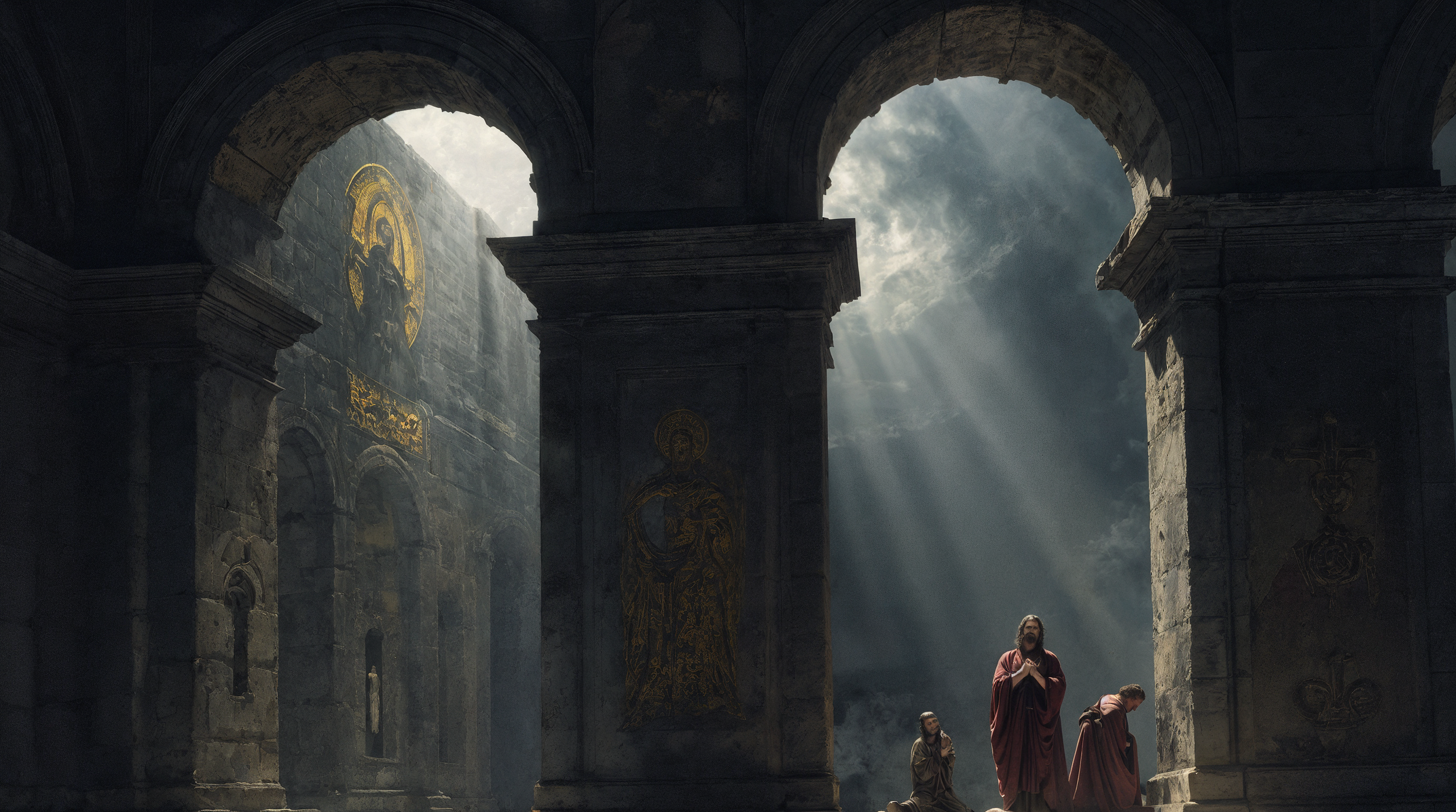Living Through Tribulation: Early Church Perspectives
Article 2 of 5 | Estimated reading time: 9 minutes
Topic: Early Christian Understanding of Persecution and Christ's Return
Modern Christians often debate whether the church will be raptured before, during, or after "the tribulation." But this entire framework would have puzzled the early church. For them, tribulation wasn't a future seven-year period to escape but their present reality to endure while expecting Christ's imminent return. Understanding how the early church lived in what we might call "imminent intratribulationism" challenges many contemporary assumptions about suffering, persecution, and the Christian life.
Three Types of Tribulation in Early Christian Thought
The early church fathers distinguished between different types of tribulation without systematizing them into our modern categories:
1. Present Tribulation (Their Daily Reality)
For the first three centuries, persecution was the normal Christian experience. The book of Revelation was written to Christians already experiencing tribulation: "I, John, your brother and companion in the tribulation..." (Rev 1:9). They didn't await tribulation; they lived in it.
Consider the testimony of Ignatius of Antioch (c. 108 AD) writing on his way to martyrdom:
"From Syria to Rome I am fighting with wild beasts, by land and sea, by night and day, being bound to ten leopards, that is, a squad of soldiers who become worse for kind treatment."
— Ignatius, Letter to the Romans 5.1
This wasn't exceptional but expected. Christians faced:
- Economic persecution (couldn't join trade guilds)
- Social ostracism (called "atheists" for rejecting Roman gods)
- Legal persecution (illegal religion until AD 313)
- Physical martyrdom (periodic intense persecutions)
2. The Destruction of Jerusalem (AD 70)
Many early Christians saw Jerusalem's destruction as fulfillment of Jesus' prophecies about tribulation (Matthew 24). The Pella tradition claims Christians fled Jerusalem before its destruction, seeing the Roman armies as the "abomination of desolation."
Eusebius records:
"The people of the church in Jerusalem were commanded by an oracle given before the war to those worthy of it to depart from the city and to dwell in a city of Perea called Pella."
— Eusebius, Ecclesiastical History 3.5.3
This wasn't seen as "the" tribulation but as "a" tribulation—a pattern that would repeat throughout history.
3. Future Intensification Under Antichrist
While living in present tribulation, many fathers expected future intensification under a personal Antichrist. Irenaeus (c. 180) expected Antichrist to reign for three and a half years (not seven), persecuting the church before Christ's return:
"When Antichrist has devastated all things in this world, he will reign for three years and six months and will sit in the temple at Jerusalem; and then the Lord will come from heaven in clouds..."
— Irenaeus, Against Heresies 5.30.4
Crucially, they expected to face this Antichrist, not escape him.
"Imminent Intratribulationism": The Early Church's Unique Position
The early church's eschatological position defies modern categories. They practiced what could be called "imminent intratribulationism"—expecting Christ's imminent return while living within ongoing tribulation. This wasn't a systematic doctrine but lived experience.
Key Characteristics:
- Already in tribulation: Not waiting for it to begin
- Expecting Christ imminently: Could return at any moment
- No escape theology: Expected to endure, not avoid
- Victory through martyrdom: Death was triumph, not defeat
The Shepherd of Hermas (c. 100) captures this dual perspective:
"You have escaped from great tribulation on account of your faith... but say to them that a great tribulation is coming. If it seems good to you, deny [the faith] a second time."
— Shepherd of Hermas, Vision 2.2
Note the paradox: they had "escaped" tribulation (spiritually) while expecting more tribulation (physically).
The Church Age as Tribulation
Rather than dividing history into "church age" (peaceful) and "tribulation" (seven years), the early church saw the entire period between Christ's ascension and return as characterized by tribulation.
Tertullian (c. 200) expressed this understanding:
"The only thing that restrains the coming of Antichrist is the Roman Empire. We have no desire, then, to be overtaken by these dire events; and in praying that their coming may be delayed, we are lending our aid to Rome's duration."
— Tertullian, Apology 32
They saw themselves living in the tension between "already" and "not yet"—already experiencing tribulation but not yet seeing its final intensification.
The Controversial Ephraem Text
One text potentially challenges this consensus: the Pseudo-Ephraem sermon "On the Last Times, the Antichrist, and the End of the World." This document contains a passage suggesting believers will be removed before tribulation:
"All the saints and elect of God are gathered together before the tribulation which is to come and are taken to the Lord..."
— Pseudo-Ephraem (date disputed)
Critical Issues:
- Dating: If 4th century (Ephraem's time), it's the earliest pre-trib hint. If 7th century (as many scholars argue), it's much later.
- Authenticity: Likely pseudonymous (falsely attributed to Ephraem)
- Context: Even if authentic, it assumes ongoing persecution unlike modern pre-trib teaching
- Minority view: One disputed text against overwhelming consensus
Even if this text is authentic 4th century, it represents a tiny minority view. The overwhelming consensus expected to face Antichrist before Christ's return.
Why No Pre-Tribulation Rapture in Early Church?
The modern pre-tribulation rapture doctrine was foreign to early Christianity for several reasons:
1. They Didn't Have a Seven-Year Framework
While some fathers mentioned 3.5 years of Antichrist's reign (half of Daniel's week), they didn't develop the complete dispensational system of a seven-year tribulation period distinct from the church age.
2. Tribulation Was Normal, Not Exceptional
When persecution is your daily experience, you don't develop theologies of escaping it. The early church's "blessed hope" was Christ's return to vindicate them, not to remove them from suffering.
3. Martyrdom Was Victory
Early Christians saw martyrdom as the ultimate participation in Christ's sufferings. Polycarp (martyred c. 155) reportedly said:
"Eighty-six years I have served Christ, and He has done me no wrong. How then can I blaspheme my King who saved me?"
— Martyrdom of Polycarp 9
Why would they expect to escape what they considered the highest honor?
4. One Return, Not Two Stages
The fathers consistently expected one visible, glorious return of Christ. The concept of a secret rapture followed by a separate visible return seven years later appears nowhere in their writings.
Different Questions, Different Answers
The early church asked different questions than we do:
Modern Questions:
- When is the rapture?
- How do we escape tribulation?
- What are the signs of the seven-year period?
Early Church Questions:
- How do we stay faithful under persecution?
- How do we prepare for martyrdom?
- How do we maintain hope while suffering?
Their questions emerged from their experience. Living under Roman persecution, they didn't speculate about escaping tribulation but about enduring it faithfully.
Modern Implications: What This Means for Today
For Western Christianity
The early church's experience challenges comfortable Christianity that expects to avoid suffering. If the norm for most of church history has been persecution, not prosperity, what does this say about our expectations?
Consider: While Western Christians debate tribulation timing, believers in North Korea, Iran, and China experience severe persecution now. The early church's "imminent intratribulationism" resonates more with their experience than with our theological systems.
For Eschatological Systems
The early church doesn't fit neatly into modern pre-trib, mid-trib, or post-trib categories because they didn't share our systematic framework. They lived in tribulation while expecting Christ—a both/and rather than either/or perspective.
This suggests our sharp distinctions between "church age" and "tribulation period" may be more systematic than biblical. Perhaps we should recover the early church's expectation of suffering as normal rather than exceptional.
For Practical Faith
The early church teaches us to:
- Expect suffering: It's normal, not surprising (1 Peter 4:12)
- Prepare for endurance: Not escape but faithfulness
- Maintain hope: Christ's return brings vindication
- Value present faithfulness: Over future speculation
Questions for Reflection
- If persecution has been normal for most of church history, how should this affect Western Christianity's expectations?
- How might our eschatology change if we experienced persecution like the early church?
- What's the difference between hoping for Christ's return to escape suffering versus to vindicate suffering?
- How do we prepare for potential persecution while living in religious freedom?
- What would "imminent intratribulationism" look like in contemporary practice?
Conclusion: Living in Creative Tension
The early church's approach to tribulation defies our systematic categories. They lived in the creative tension of experiencing tribulation while expecting Christ, enduring suffering while maintaining hope, facing martyrdom while proclaiming victory. They didn't have answers to our questions about rapture timing because they were asking different questions entirely.
Perhaps their greatest gift to modern eschatology isn't answers but perspective. They remind us that for most Christians throughout history, tribulation hasn't been a future period to debate but a present reality to endure. They lived in the tension of expecting Christ's imminent return while experiencing ongoing persecution. They distinguished between tribulation they must endure and wrath from which they'd be protected. They prepared not for escape but for endurance.
The controversial Ephraem text, whether 4th or 7th century, shows some early Christians did conceive of removal before specific future tribulation. Yet this remained a minority view, and even this text assumes a context of normal Christian suffering vastly different from modern pre-tribulationism's peaceful church age.
Perhaps the early church's greatest gift to modern eschatological debates is not a clear answer to our questions but a challenge to our categories. They remind us that faithful Christian living means maintaining hope in Christ's return not despite tribulation but through it.
← Previous: The "Spiritual Israel" Innovation | Next: From Chiliasm to Amillennialism →
See also: Modern Relevance | Glossary | Primary Sources

